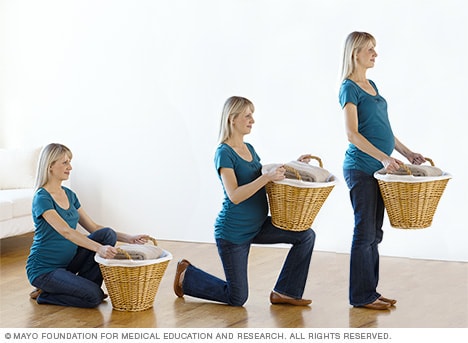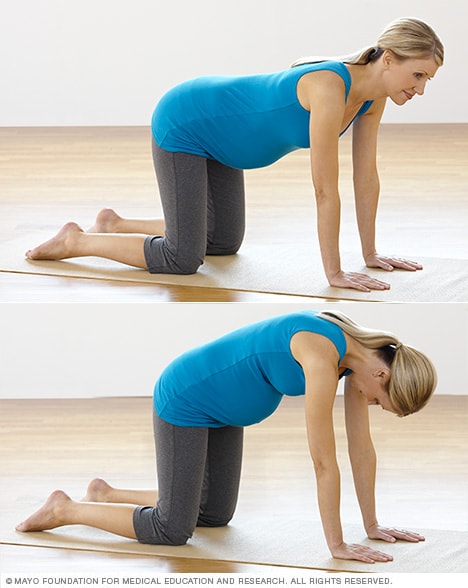Back pain during pregnancy: 7 tips for relief
Back pain during pregnancy isn't surprising, but it still deserves attention. Try seven ways to relieve back pain during pregnancy — from good posture and physical activity to complementary therapies.
By Mayo Clinic Staff
Proper lifting during pregnancy
Proper lifting during pregnancy

Proper lifting during pregnancy
To lift correctly, bend at your knees — not at your waist. Keep your back as straight as possible. Use your leg muscles to stand, keeping the object close to your body.
Low back stretch
Low back stretch

Low back stretch
During pregnancy, the low back stretch might ease back pain. Rest on your hands and knees with your head in line with your back. Pull in your stomach, rounding your back slightly. Hold for several seconds, then relax your stomach and back — keeping your back as flat as possible. Gradually work up to 10 repetitions.
Back pain during pregnancy is common. Changes in the body often play a role in that. You gain weight. Your center of gravity changes. Muscles in the stomach area that support the spine stretch and weaken. Hormones relax connective bands of tissue, called ligaments, in the joints of your pelvis.
Often, though, you can prevent or ease back pain during pregnancy. Try these seven ways to get relief.
1. Practice good posture
As your baby grows, your center of gravity shifts forward. You might lean back to keep yourself from tipping forward. But leaning back can strain the muscles in your lower back. Straining muscles can play a role in back pain during pregnancy.
Keep these tips for good posture in mind:
- Stand up straight and tall.
- Hold your chest high.
- Keep your shoulders back and relaxed.
- Keep your knees slightly bent. Don't lock them.
When you stand, use a comfortably wide stance for the best balance. If you must stand for a long time, rest one foot on a low step stool. This eases the strain on your back. Take time for frequent breaks too.
It's also important to sit with good posture. Choose a chair that supports your back. Or place a small pillow behind your lower back. Some stores sell lumbar support pillows and cushions designed to support the back while sitting.
2. Get the right gear
Wear low-heeled — not flat — shoes that support the arches of your feet. Good choices include walking or athletic shoes. Don't wear high heels. They can further shift your balance forward and cause you to fall. High heels can strain the muscles in your lower back too.
You also can get back support by wearing an abdominal support garment, also known as an abdominal or pregnancy binder. It's a clothing item that can take some of the weight of your stomach off of your back muscles. Some pants made for pregnant people help support stomach weight as well. They include an elastic band that goes under the curve of the belly.
You also might think about wearing a pelvic support belt. Research on how well these belts work is mixed. But some pregnant people find the extra support helpful. If you choose to try a support belt, bring it to one of your medical appointments. Your healthcare professional can help show you the best way to wear and position the belt.
3. Lift properly
When you lift a small object, first make sure you have stable footing. Then, squat down with a wide stance and bend your knees. Keep your back straight as you lift with your leg strength. Don't bend at the waist or lift with your back. Also, know your limits and ask for help if you need it.
4. If possible, sleep on your side
Many pregnant people find that sleeping on the side, rather than on the stomach or back, helps ease back pain. Keep one or both knees bent in a neutral position. Try using pregnancy or support pillows. You can place the pillows between your bent knees, under your stomach and behind your back. Full-length body pillows also are available.
5. Try heat, cold or massage
A heating pad, hot pack, warm water bottle or ice pack placed on your back can give sore muscles relief. If you use a heating pad, set it to the lowest temperature. Wrap the pad or a warm water bottle in a towel to lower the chance of burns.
A back massage also might help. It's not proven to ease low back pain for long amounts of time, but it may help you feel better.
6. Stay active
Regular physical activity can keep your back strong and might relieve back pain during pregnancy. It's important to keep doing the physical activities that you did before pregnancy. These might include walking, running or water exercise. A physical therapist also can show you stretches and exercises that might help. Physical therapy may help if heat, cold, massage and exercise don't ease your back pain.
You can stretch your lower back as well. One way to do this is to rest on your hands and knees with your head in line with your back. Pull in your stomach, rounding your back slightly. Hold for several seconds, then relax your stomach and back — keeping your back as flat as possible. Over time, work up to 10 repetitions. Many pregnant people find prenatal stretching and strength classes such as yoga helpful. Ask your healthcare professional or physical therapist about other stretching exercises too.
7. Consider complementary therapies
Some research suggests that acupuncture might relieve back pain during pregnancy. With acupuncture, a trained practitioner places very thin needles through your skin at strategic points on your body. Some studies suggest that chiropractic treatment also might help. With chiropractic treatment, a trained and licensed specialist uses the hands or a small instrument to adjust your spine. If you want to try a complementary therapy, check with your healthcare professional first. And be sure to tell the chiropractor or acupuncturist that you're pregnant.
Know when to call your healthcare professional
If you have serious back pain during pregnancy, tell a member of your healthcare team. Also talk with a healthcare professional if you fall or get injured while pregnant. Your care team might want to monitor the health of you and the baby. If back pain lasts more than two weeks, contact a member of your care team. Your healthcare professional might recommend medicine such as acetaminophen (Tylenol, others) or other treatments.
Back pain during pregnancy could be a symptom of preterm labor or a urinary tract infection. Call your healthcare professional right away if you have back pain along with any of the following:
- Vaginal bleeding.
- Fever.
- Cramping or contractions.
- A burning feeling during urination.
March 12, 2024
- Bermas BL. Maternal adaptations to pregnancy: Musculoskeletal changes and pain. https://www.uptodate.com/contents/search. Accessed Nov. 28, 2023.
- FAQs: Back pain during pregnancy. American College of Obstetricians and Gynecologists. https://www.acog.org/womens-health/faqs/back-pain-during-pregnancy. Accessed Nov. 28, 2023.
- American College of Obstetricians and Gynecologists. Your Pregnancy and Childbirth: Month to Month. Kindle edition. 7th ed. American College of Obstetricians and Gynecologists; 2021. Accessed Nov. 29, 2023.
- Maintaining good posture. American Chiropractic Association. https://www.acatoday.org/patients/posture/. Accessed Dec. 1, 2023.
- Liddle SD, et al. Interventions for preventing and treating low-back and pelvic pain during pregnancy. Cochrane Database of Systematic Reviews. 2015; doi:10.1002/14651858.CD001139.pub4. Accessed Nov. 29, 2023.
- Knight CL, et al. Treatment of acute low back pain. https://www.uptodate.com/contents/search. Accessed Nov. 28, 2023.
- Davenport MH, et al Exercise for the prevention and treatment of low back, pelvic girdle and lumbopelvic pain during pregnancy: A systematic review and meta-analysis. British Journal of Sports Medicine. 2019; doi:10.1136/bjsports-2018-099400.
- Yang J, et al. Acupuncture for low back and/or pelvic pain during pregnancy: A systematic review and meta-analysis of randomised controlled trials. BMJ Open. 2022; doi:10.1136/bmjopen-2021-056878.
- Mattison D, et al., eds. Herbs and alternative medicine. In: Clinical Pharmacology During Pregnancy. 2nd ed. Elsevier; 2022. https://www.clinicalkey.com. Accessed Nov. 29, 2023.
- Medical review (expert opinion). Mayo Clinic. Dec. 4, 2023.
- Jang J, et al. Balance (perceived and actual) and preferred stance width during pregnancy. Clinical Biomechanics. 2008; doi:10.1016/j.clinbiomech.2007.11.011.
- Goossens N, et al. Changes in static balance during pregnancy and postpartum: A systematic review. Gait & Posture. 2022; doi:10.1016/j.gaitpost.2022.05.033.